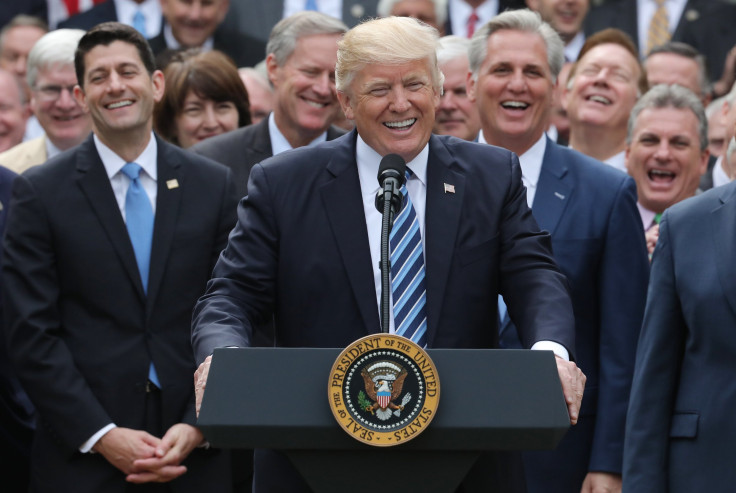Are Pre-Existing Conditions Still Covered? Insurance Industry May Have Lobbied To Block Protection In AHCA

A few days after Barack Obama was elected president in 2008, major health insurance companies proposed a deal. In a press release from America’s Health Insurance Plans — the trade association for the industry — insurers said that in exchange for legislation requiring Americans to buy medical insurance, they would agree to accept provisions requiring them to provide “guaranteed coverage for people with pre-existing medical conditions.”
That breakthrough compromise was one of the key foundations of the entire Affordable Care Act and it appeared to bring the politically powerful insurance industry into a coalition committed to making Obamacare work. Despite the apparent compromise, though, the industry wasn’t done fighting. After the 2010 passage of the ACA, the industry kept lobbying on the pre-existing condition issue — and this week, the House passed a bill to repeal the ban on insurance companies discriminating against sick people.
An International Business Times review of federal records shows that America’s Health Insurance Plans (AHIP) listed the pre-existing condition issue on disclosure forms documenting nearly $81 million worth of lobbying since the passage of the ACA. Also lobbying on the issue were Anthem, Kaiser, Blue Cross Blue Shield and the National Association of Health Underwriters.
Many of the federal records reviewed by IBT do not provide granular details of the industry’s lobbying on the pre-existing condition issue. For instance, on the 35 AHIP reports filed since 2010, the group said it was lobbying on the “pre-existing condition exclusion” and “pre-existing condition insurance plans.” In 2017, the lobbying records became somewhat more explicit: The group, as well as Anthem and Blue Cross, said they were lobbying on a bill designed to prevent discrimination against patients with a pre-existing condition in the event that the Affordable Care Act was repealed.
For their part, insurers have publicly asserted that they do not want to discriminate against people with pre-existing medical conditions.
“AHIP believes that every American deserves coverage and care that is affordable and accessible, including those with pre-existing conditions,” the group said in a statement after the passage of the House bill.
In the leadup to the House vote, though, AHIP had been more publicly signaling its discomfort with how the pre-existing condition protections were working in the ACA.
“No individual should be denied or priced out of coverage because of their health status,” AHIP President Marilyn Tavenner told a House panel in February. “However, with this as a principle, modifications to existing insurance reforms are needed.”
Among the modifications that passed the House a few weeks later was a provision allowing states to waive the federal protection for people with pre-existing conditions. Insurance companies in those states would be able to place those people — who make up an estimated 27 percent of American adults under age 65 — into high-risk pools with yearly premiums of what an AARP report projected could reach $25,700 by 2019. The states would receive $138 million over the next decade to help cover the costs of insuring those Americans.
Sabrina Corlette, a research professor at the Center on Health Insurance Reforms of Georgetown University’s Health Policy Institute, said that while she couldn’t speak on behalf of health insurance companies, she believed the loss of two major revenue boosts for the industry likely pushed them to battle against the protection ahead of the AHCA’s passage in the House.
“The insurance companies would’ve looked with a lot of nervousness at the measure that repealed the insurance mandate penalty,” she said, referring to the Obamacare measure that imposed a tax on individuals (often those who are young and healthy) who didn’t buy some form of coverage. That, coupled with the AHCA’s “dramatically” cutting subsidies that help low-income people purchase health insurance, she said, would inevitably leave insurers with smaller, disproportionately unhealthy and expensive markets.
“I would imagine with those two provisions in the underlying bill, they would be worried that the only people with insurance would be sick people,” Corlette said. “You take those two legs of the stool away, and it doesn’t really work.”
Ahead of the ACA’s passage in 2010, AHIP reportedly advocated for the pre-existing conditions protection, but only if the health care law would include a mandate requiring all Americans, even healthy ones who might not normally purchase insurance, to buy coverage — a requirement that would amount to a revenue boost for the industry. Many outlets, such as ABC News, characterized the final results as a trade-off for insurers. Congressional Republicans, as Corlette noted, took away the government’s two bargaining chips when constructing the AHCA.
Still, even with those two bargaining chips in place in 2010, the industry wasn’t fully onboard. Soon after Obamacare’s passage, insurance firms angered Democrats by interpreting the pre-existing conditions provision’s fine print to mean that they wouldn’t have to write new insurance policies for children with such medical problems or have to make such coverage available for Americans in general until 2014.
© Copyright IBTimes 2024. All rights reserved.






















